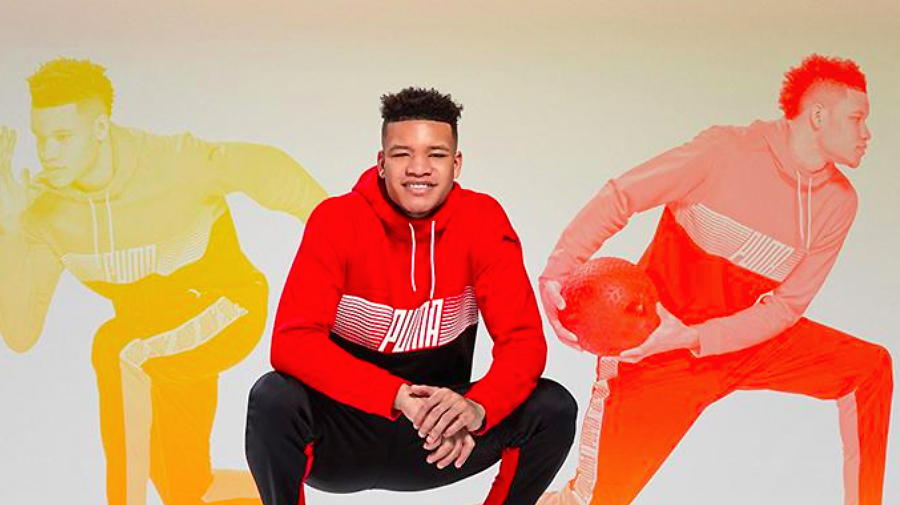By Thomas J. Ryan
<span style="color: #808080;">With robust growth in China and the U.S. and a healthy reception to its return to performance basketball, Puma SE kicked off the year with its strongest quarter ever.
Sales in the first quarter jumped 15.3 percent on a currency-adjusted basis (16.6 percent reported) to €1.32 billion.
By region, the strongest growth was seen in Asia/Pacific, which grew 28.6 percent on a currency-neutral basis (32.5 percent reported) to €401.0 million. The gains were driven by China.
Sales in the Americas expanded 16.3 percent on a currency-neutral basis (19.8 percent reported) to €416.6 million. In the EMEA region, sales were up 5.7 percent on a currency-neutral basis (4.4 percent reported) to €501.7 million.
By product category, the strongest growth came in apparel, leaping 26.9 percent on a currency-neutral basis (28.6 percent reported) to €468.4 million. Footwear, its largest category, advanced 9.3 percent on a currency-neutral basis (10.2 percent reported) to €639.3 million. Accessories’ sales grew 11.0 percent on a currency-neutral basis (13.4 percent reported) to €211.6 million.
The categories Running and Training, Teamsport, Motorsport and Golf on the performance side as well as Sportstyle all recorded strong growth. Double-digit increases came from both wholesale and direct-to-consumer (DTC) channels.
Net earnings jumped 40.1 percent to €94.4 million, or €6.31 a share.
”A very good start to the year,” said Bjørn Gulden, CEO, on a media call. “The growth in all regions and all product divisions shows that we continue to make progress.”
Puma retained its guidance for the year.
The earnings hike was boosted by an improvement in gross margins by 80 basis points to 49.0 percent. Margins benefited from a favorable product mix with higher growth in apparel and a favorable regional sales mix with higher sales growth in the Asia/Pacific region. Currency effects also had a slightly positive impact on gross margin.
Operating expenses rose 16.8 percent to €510.7 million in the quarter, mainly caused by higher sales-related variable costs, including logistics costs as well as higher marketing and retail investments. As a percent of sales, operating expenses were the same 38.7 percent this year and last year.
Earnings before interest and taxes (EBIT) improved 27.0 percent to €142.5 million due to the higher sales and margin improvement. EBIT margins improved 10.8 percent compared to 9.9 percent in the first quarter last year.
On the call, Gulden said the reception to its two basketball models, The Clyde and Uproar, has been “very good” online and more varied by market depending on the visibility of Puma’s endorsed NBA players.
Puma announced its return last September and has since signed seven NBA players: DeMarcus Cousins, Rudy Gay, Kevin Knox, Marvin Bagley III, Terry Rozier, Michael Porter Jr. and DeAndre Ayton. Puma had already signed WNBA star Skylar Diggins-Smith the prior year.
The brand also launched the category in the U.S. Basketball will reach other regions in the third quarter with a big push planned around the 2019 FIBA Basketball World Cup that takes place in September in China.
“So far, basketball has done the job that we expected it to do,” said Gulden. “There’s a big interest from retailers, there’s a lot of noise in social media, and there’s lovers and haters, which is exactly what we wanted to have. I think the players that we signed, you know, was a surprise. And they have more or less all done the job. We’ve been a little bit unlucky with injuries.”
All-Star center DeMarcus Cousins was injured in mid-April and is expected to miss the playoffs for the Golden State Warriors.
Asked about the basketball category’s profitability, Gulden said that given the investment in players, it’s unprofitable. But the brand entered the category for the “halo effect” benefit on lifestyle basketball ranges and other performance categories. He said the brand uses the same strategy for soccer.
“We have made a lot of noise in the American market by doing this. And I think the timing was the right one, maybe we should have done it before, to be honest,” said Gulden. “And the interest of both retailers and also the consumer, that young kid, has increased. And, and so far we’re very happy. You know, we told you in the beginning that we don’t expect to take a lot of market share away from Nike and be a big player in the beginning, that we have a plan and we stick to the plan. And so far, we have achieved what we internally have set.”
Two more basketball styles will hit the market this year and Puma also expects to be active signing more players around the upcoming NBA Draft. Puma is also not spending more on marketing to support its entry. Advertising remains around 11 percent of sales with the money spent on basketball coming from past investments in men’s lifestyle, an area expected to benefit from its new basketball positioning.
Asked about best sellers overall in the quarter, Gulden said the “very strong development” in apparel is running across categories, including lifestyle and performance products as well as in women’s.
In footwear, the chunky style “as a segment has been very successful” with Puma led by its RS-X model, but court and “a lot of normal silhouettes” are also selling well.
He said that the company was “quite nervous” when the Classics business began slowing down 10 months ago but launches of some higher-priced as well as take-down models “have done very well.” Puma is also benefiting from broader coverage over past years. Said Gulden, “It’s obvious that in many markets, Puma is more accepted than it was a year, two, three and four years ago. And that’s why we’re selling on a wider scale.”
Looking ahead, he said that while the chunky trend remains strong, there are indications that low-profile and motorsport footwear are making comebacks. The CEO added, ”There are even signs that retro running is coming back again.”
Across genders, Gulden said women’s overall had been steadily outpacing men’s until the middle of last year when the brand began benefiting from its marketing investments in basketball and soccer. He said, “It’s now more balanced.”
Responding to a question, he said Puma’s women celebrity endorsements, including with singer Rihanna, supermodel Adriana Lima and actress Selena Gomez, have helped bring “brand heat” to the brand but he implied the celebrity focus may change. He said the use of celebrities is partly because there are “very few female sports heroes” compared to men. He blamed that on lack of media coverage but also poor promotion from the industry and called it “something that we have to work harder on.”
Regarding its outlook, Gulden said that despite the outperformance in the quarter, “it’s a little bit early” to lift guidance for the year with three quarters left and continued “uncertainty” in the marketplace. Most of the uncertainties, he noted, have been around for the last twelve months, including the tariff dispute between the U.S. and China, Brexit in the U.K., and currency headwinds, particularly Turkey and Argentina.
The sourcing challenges resulting from the tariff dispute caused inventories to be up 19.3 percent at the quarter’s end, ahead of its sales growth. Gulden said Puma is “running a little bit after demand,” especially expecting “a lot of unplanned orders” to arrive for the RS-X chunky styles.
For the full year, Puma continues to expect:
- Sales: currency-adjusted growth of around 10 percent
- Gross profit margin: slight improvement compared to last year’s 48.4 percent
- Operating expense: increase at a slightly lower rate than sales
- EBIT: in a range between €395 million and €415 million
- Net earnings: significant improvement.
Photo courtesy Puma
















